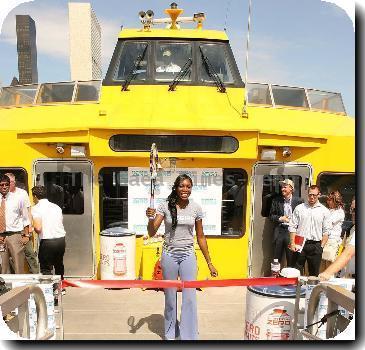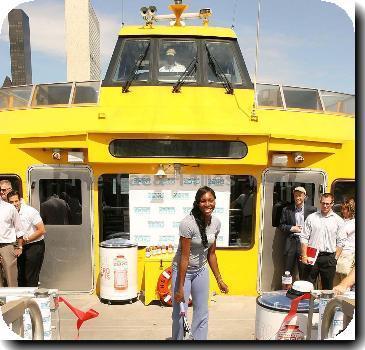Isner, Querrey move into US Open’s 3rd round; Harrison comes close as can be but doesn’t
By Howard Fendrich, APFriday, September 3, 2010
Isner, Querrey reach 3rd round, Harrison doesn’t
NEW YORK — “Let’s go, Ryan!” Clap-clap-clap-clap-clap.
“Let’s go, Ryan!” Clap-clap-clap-clap-clap.
On his way to victory at Louis Armstrong Stadium on Friday, the highest-seeded American man left in the U.S. Open, No. 18 John Isner, could hear the wild cheering and chanting going on at the adjacent Grandstand in support of another American man, Ryan Harrison, a qualifier who was the lowest-ranked (220) and youngest (18) player still in the tournament.
Isner, striving to be known for more than winning the longest tennis match in history, reached the third round by beating Marco Chiudinelli of Switzerland 6-3, 3-6, 7-6 (7), 6-4.
Harrison, striving to show he belongs at this level, came as close as possible to winning without doing so, wasting three match points in the fifth-set tiebreaker and losing 6-3, 5-7, 3-6, 6-3, 7-6 (6) to Sergiy Stakhovsky of Ukraine.
“I’m trying to hopefully get to the top 10, so I feel like one match doesn’t make or break that,” Harrison said, doing his best to look on the bright side. “It’s the experience of playing these type of matches that is really going to help me to get there.”
This was the second Grand Slam tournament of Harrison’s nascent career, and the first at which he won a match — and what a victory it was, an upset over 15th-seeded Ivan Ljubicic.
For Isner, this is the first major tournament he’s played since Wimbledon in June, when he hit a record 113 aces during an 11-hour-plus, 183-game, first-round marathon spread over three days. He beat Nicolas Mahut in a 70-68 fifth set, and while appreciative of the significance of that match, Isner is quite ready to move on.
“I don’t want that to be, like, the lasting image of my career,” the 6-foot-9 Isner said after finishing with 24 aces against the 63rd-ranked Chiudinelli. “So that’s up to me to make it not that way. It’s up to me to do well in big tournaments, tournaments such as this.”
He can match his best Grand Slam showing if he beats No. 12 Mikhail Youzhny to make it to the fourth round.
Isner, who won an NCAA championship at the University of Georgia, was joined in the third round by No. 20 Sam Querrey, a 6-2, 6-3, 6-4 winner Friday against Marcel Granollers of Spain. Of 15 U.S. men originally in the draw, four are left: Isner, Querrey, No. 19 Mardy Fish and wild card James Blake. Fish and Blake play third-round matches Saturday.
“Hopefully it’ll continue on, and hopefully, James and Mardy and other Americans will keep moving forward, too,” said Querrey, who now faces No. 4 Andy Murray, the 2008 runner-up in New York.
For comparison’s sake, there are nine Spanish men in the third round, seven of whom won Friday, led by No. 1-seeded Rafael Nadal.
Murray beat Jamaica’s Dustin Brown 7-5, 6-3, 6-0, and other seeded winners included No. 8 Fernando Verdasco, No. 10 David Ferrer, No. 23 Feliciano Lopez and No. 31 David Nalbandian. The only seeded man to exit Friday was No. 29 Philipp Kohlschreiber, who lost 4-6, 6-3, 1-6, 6-1, 6-3 to former top-10 player Gilles Simon. Now Simon will try to end Nadal’s 17-match winning streak in Grand Slam tournaments.
Nadal saved all seven break points he faced in his 6-2, 7-6 (5), 7-5 victory over 39th-ranked Denis Istomin in Arthur Ashe Stadium at night, after 2000-01 champion Venus Williams easily got past 185th-ranked qualifier Mandy Minella of Luxembourg 6-2, 6-1.
“I had no idea what my opponent played like,” Williams said afterward, but apparently it didn’t matter, and she accumulated a 29-5 advantage in winners while her injured sister Serena watched from the stands.
Next for the older Williams is No. 16 Shahar Peer, who beat No. 19 Flavia Pennetta 6-4, 6-4.
There were no upsets in women’s third-round play, other than, perhaps, the fact that Kim Clijsters lost the first three games of her match before coming back to defeat No. 27 Petra Kvitova 6-3, 6-0.
French Open champion Francesca Schiavone, French Open runner-up Sam Stosur, two-time major finalist Elena Dementieva, and former No. 1 Ana Ivanovic all won, all in straight sets. The highlight, without a doubt, was Schiavone’s back-to-the-net, between-the-legs shot in her 6-1, 7-5 victory over No. 29 Alona Bondarenko — nearly identical to what Roger Federer has done each of the past two years at the U.S. Open.
Schiavone said she was looking forward to seeing a replay, which will be easy, because, like Federer’s efforts, her shot was quickly posted on YouTube.
“I’d like to see it again,” Schiavone said. “I’m curious.”
Querrey watched “pretty much the entire fourth and fifth set” of Harrison’s loss, which he called a “tough one.”
“I was in the lunchroom,” Querrey said. “Everyone had their eyes glued to the TV.”
Harrison went ahead 6-3 in the deciding tiebreaker against the 36th-ranked Stakhovsky, who won a hard-court title at New Haven, Conn., last week. Had he won any of the next three points, Harrison would have gone on to try to become the youngest American man to reach the fourth round of the U.S. Open since 17-year-old Michael Chang in 1989. Pete Sampras also made the fourth round in New York that year, at 18, and won the title in 1990 at 19.
“Didn’t really seem that he’s going to choke,” Stakhovsky would say later.
But Stakhovsky took the next five points to end it. He hit an overhead winner, then a service winner, and Harrison closed a nine-stroke exchange by dumping a backhand into the net to make it 6-all.
“Just kind of, you know, fell apart from there,” Harrison acknowledged.
On the next point, Harrison double-faulted for the eighth time, giving Stakhovsky a 7-6 lead and a match point, which he converted with a forehand volley.
“Just got a little bit tight whenever I needed to come through,” Harrison said.
He certainly couldn’t complain about which way the crowd was rooting at the 6,106-capacity Grandstand. Stakhovsky estimated he heard no more than 50 people shouting for him in Russian and summed up the scene this way: “It was nice, I mean, except that 99.9 percent of the people were against me.”
Isner’s match was going on simultaneously next door and he couldn’t exactly tell what was happening, of course.
“When the crowd cheered, you know, that was when Ryan won a point,” Isner explained.
Both of those matches were halted for less than a half-hour by a rain delay when the outer edges of Hurricane Earl made a passing appearance. But otherwise, play carried on under gray clouds and in temperatures in the 80s instead of the 90s during the first four days of the U.S. Open.
Tags: Events, Hurricane earl, Mandy minella, Men's Tennis, New York, North America, Rafael nadal, Roger federer, Ryan harrison, U.s. Open Tennis Championship, United States, Venus williams, Women's Sports, Women's Tennis, Youtube



